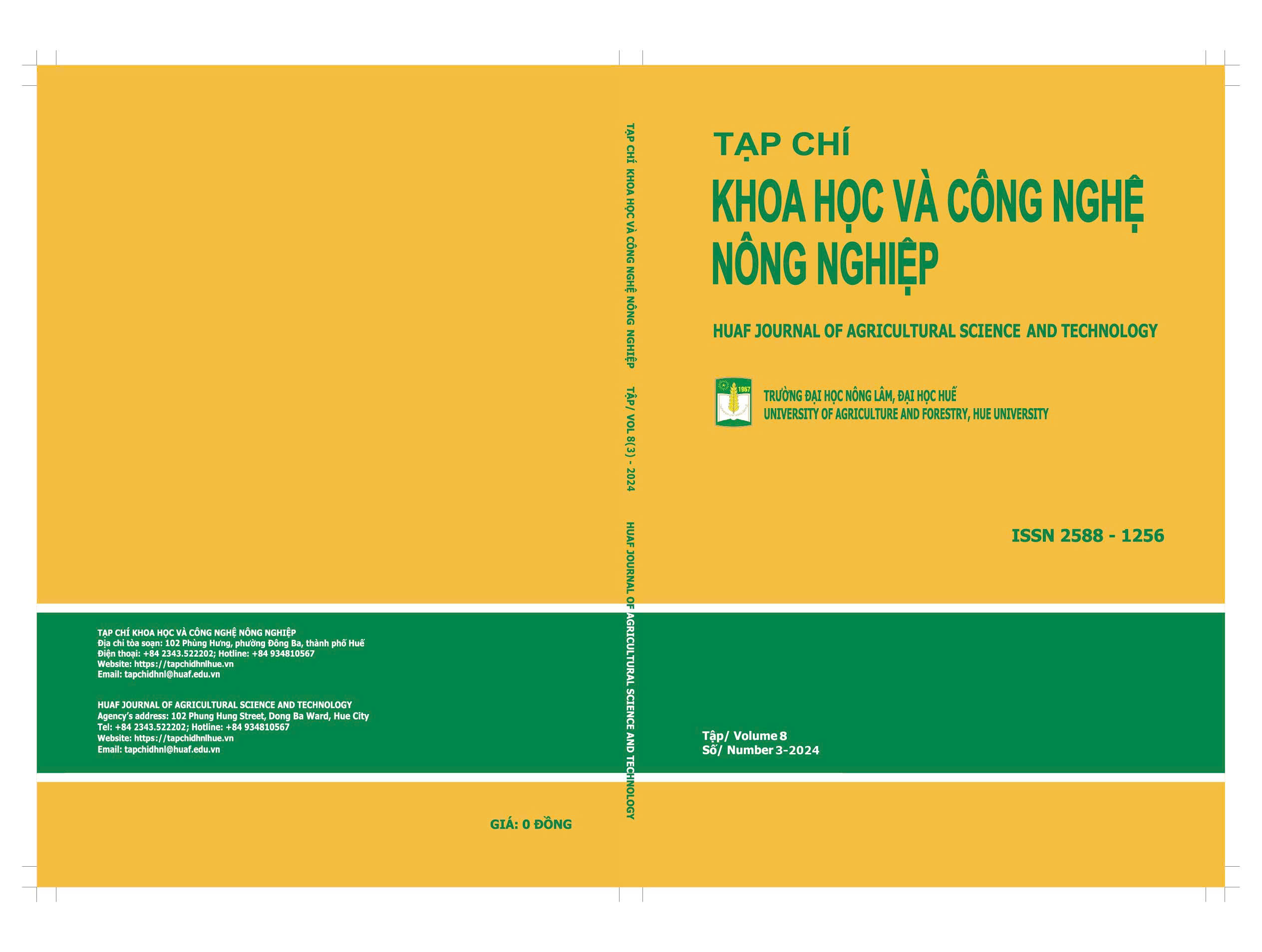##plugins.themes.huaf_theme.article.main##
Tóm tắt
Vi khuẩn Riemerella anatipestifer (RA) gây bệnh nhiễm trùng huyết ở vịt, là một nguyên nhân quan trọng gây thiệt hại kinh tế đối với ngành chăn nuôi vịt. Để phòng bệnh cho đàn vịt, sử dụng vắc-xin là biện pháp hiệu quả nhất. Tuy nhiên, do sự đa dạng về serotype, và hạn chế miễn dịch chéo của các serotype nên việc nghiên cứu vắc-xin đa giá là hết sức cần thiết. Trong nghiên cứu này, chúng tôi tiến hành nghiên cứu chất bổ trợ, đường tiêm, liều tiêm của vắc-xin đa giá phòng bệnh nhiễm trùng huyết vịt sử dụng 2 chủng vi khuẩn RA thuộc 2 serotype khác nhau phổ biến ở Việt Nam. Kết quả nghiên cứu cho thấy: keo phèn và montanide ISA 71 VG đều là chất bổ trợ phù hợp với kháng nguyên của vi khuẩn RA để sản xuất vắc-xin phòng bệnh nhiễm trùng huyết ở vịt. Đường sử dụng vắc-xin phòng bệnh nhiễm trùng huyết phù hợp là tiêm bắp thịt; liều sử dụng trên vịt 2 tuần tuổi phù hợp là 0,5mL vắc-xin/con. Đã tiến hành sản xuất 05 lô vắc-xin, kết quả cho thấy là cả 05 lô đều đạt tiêu chuẩn an toàn và hiệu lực theo tiêu chuẩn hiện hành.
##plugins.themes.huaf_theme.article.details##
Tài liệu tham khảo
Lê Đình Hải, Đặng Văn Tuấn, Vũ Khắc Hùng và Tăng Mạnh Nhật. (2024). Đánh giá khả năng sinh trưởng, độc lực và đáp ứng miễn dịch của chủng vi khuẩn Riemerella anatipestifer phân lập từ vịt bị bệnh nhiễm trùng huyết tại Việt Nam. Khoa học kỹ thuật thú y, 31(2), 42-50.
Chang, F.F., Chen, C.C., Wang, S.H., & Chen, C.L. (2019). Epidemiology and Antibiogram of Riemerella anatipestifer Isolated from Waterfowl Slaughterhouses in Taiwan. Journal of Veterinary research, 63 (1), 79-86. DOI: 10.2478/jvetres-2019-0003.
Chen, Y.P., Lee, S.H., Chou, C.H., & Tsai, H.J. (2012). Detection of florfenicol resistance genes in Riemerella anatipestifer isolated from ducks and geese. Veterinary microbiology, 154, 325-331. DOI: https://DOI.org/10.1016/j.vetmic.2011.07.012
Chen, Y.P., Tsao, M.Y., Lee, S.H., Chou, C.H., & Tsai, H.J. (2010). Prevalence and molecular characterization of chloramphenicol resistance in Riemerella anatipestifer isolated from ducks and geese in Taiwan. Avian Pathology, 39, 333-338. DOI: 10.1080/03079457.2010.507761
Chu, C.Y., Liu, C.H., Liou, J.J., Lee, J.W., & Cheng, L.T. (2015). Development of a subunit vaccine containing recombinant Riemerella anatipestifer outer membrane protein A and CpG ODN adjuvant. Vaccine, 33, 92-99. DOI: 10.1016/j.vaccine.2014.11.010.
Doyle, M.E. (2015). Multidrug-resistant pathogens in the food supply. Foodborne Pathogens and Disease, 12, 261-279. DOI: 10.1089/fpd.2014.1865.
Hess, C., Enichlmayr, H., Jandreski-Cvetkovic, D., Liebhart, D., Bilic, I., & Hess, M. (2013). Riemerella anatipestifer outbreaks in commercial goose flocks and identification of isolates by MALDI-TOF mass spectrometry. Avian Pathology, 42, 151-156. DOI: 10.1080/03079457.2013.775401.
Kang, M., Seo, H.S., Soh, S.H., & Jang, H.K. (2018). Immunogenicity and safety of a live Riemerella anatipestifer vaccine and the contribution of IgA to protective efficacy in Pekin ducks. Veterinary microbiology, 222, 132-138. DOI: 10.1016/j.vetmic.2018.07.010.
Leavitt, S., & Ayroud, M. (1997). Riemerella anatipestifer infection of domestic ducklings. Canadian Veterinary Medical Association, 38, 113.
Liang, Z., Li, H., Yang, D., Yin, L., Wu, Y., Liu, J., & Zhou, Q. (2024). A novel bivalent inactivated vaccine for ducks against Riemerella anatipestifer based on serotype distribution in southern China. Poultry science, 103, 103427. DOI: 10.1016/j.psj.2024.103427.
Liu, H., Wang, X., Ding, C., Han, X., Cheng, A., Wang, S., & Yu, S. (2013). Development and evaluation of a trivalent Riemerella anatipestifer-inactivated vaccine. Clinnical and Vaccine Immunology, 20, 691-697. DOI:10.1128/CVI.00768-12.
Lyu, Z., Han, S., Li, J., Guo, Z., Geng, N., Lyu, C., Qin, L., & Li, N. (2023). Epidemiological investigation and drug resistance characteristics of Riemerella anatipestifer strains from large-scale duck farms in Shandong Province, China from March 2020 to March 2022. Poultry science, 102, 102759. DOI: 10.1016/j.psj.2023.102759
Pathanasophon, P., Phuektes, P., Tanticharoenyos, T., Narongsak, W., & Sawada, T. (2002). A potential new serotype of Riemerella anatipestifer isolated from ducks in Thailand. Avian Pathology, 31, 267-270. DOI: 10.1080/03079450220136576.
Sandhu, T. (1979). Immunization of White Pekin ducklings against Pasteurella anatipestifer infection. Avian Disease, 23, 662-669. DOI: 10.2307/1589742.
Shousha, A., Awad, A., & Younis, G. (2021). Molecular Characterization, Virulence and Antimicrobial Susceptibility Testing of Riemerella anatipestifer Isolated from Ducklings. Biocontrol Science, 26, 181-186. DOI: 10.4265/bio.26.181
Sun, N., Liu, J.H., Yang, F., Lin, D.C., Li, G.H., Chen, Z.L., & Zeng, Z.L. (2012). Molecular characterization of the antimicrobial resistance of Riemerella anatipestifer isolated from ducks. Veterinary microbiology, 158, 376-383. DOI: 10.1016/j.vetmic.2012.03.005
Vo, T.T., Dang, V.T., Le, D.H., & Nguyen, T.H. (2022). Identification, serotyping, and antimicrobial susceptibility of Riemerella anatipestifer isolated from ducks in Vietnam. Open Veterinary Journal, 12, 391-398. DOI: 10.5455/OVJ.2022.v12.i3.13
Wang, X., Yue, J., Ding, C., Wang, S., Liu, B., Tian, M., & Yu, S. (2016). Deletion of AS87_03730 gene changed the bacterial virulence and gene expression of Riemerella anatipestifer. Science report, 6, 22438. DOI: 10.1038/srep22438.
